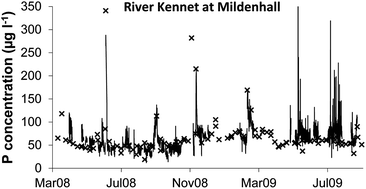High-frequency phosphorus monitoring of the River Kennet, UK: are ecological problems due to intermittent sewage treatment works failures?
Abstract
The River Kennet in southern England has exhibited excessive benthic algal growth and associated ecological problems, such as loss of macrophytes and invertebrates, since the 1980s. These ecological problems were attributed to regular peaks in phosphorus concentration, which were widely attributed to intermittent failures of the Marlborough sewage treatment works (STW). This study deployed high-frequency phosphorus auto-analysers to monitor the total reactive phosphorus (TRP) concentrations of Marlborough STW final effluent and the downstream River Kennet at hourly and 30 minute resolution respectively, between 2008 and 2009. This monitoring confirmed that the Marlborough STW was operating well within its 1000 μg l−1 annual mean total phosphorus consent limit, with mean total P and soluble reactive P concentrations of 675 and 345 μg l−1 respectively. There were two occasions where effluent TRP concentration exceeded 1000 μg l−1, and only one of these resulted in a peak in TRP concentration of over 100 μg l−1 in the River Kennet at Mildenhall. The other nine peaks of over 100 μg l−1 in the River Kennet during the monitoring period were associated with storm events, indicating that diffuse-source inputs and remobilisation of stored within-channel phosphorus were the cause of the peaks in river concentration, rather than Marlborough STW. The value of high-frequency environmental monitoring and the problems associated with using


 Please wait while we load your content...
Please wait while we load your content...